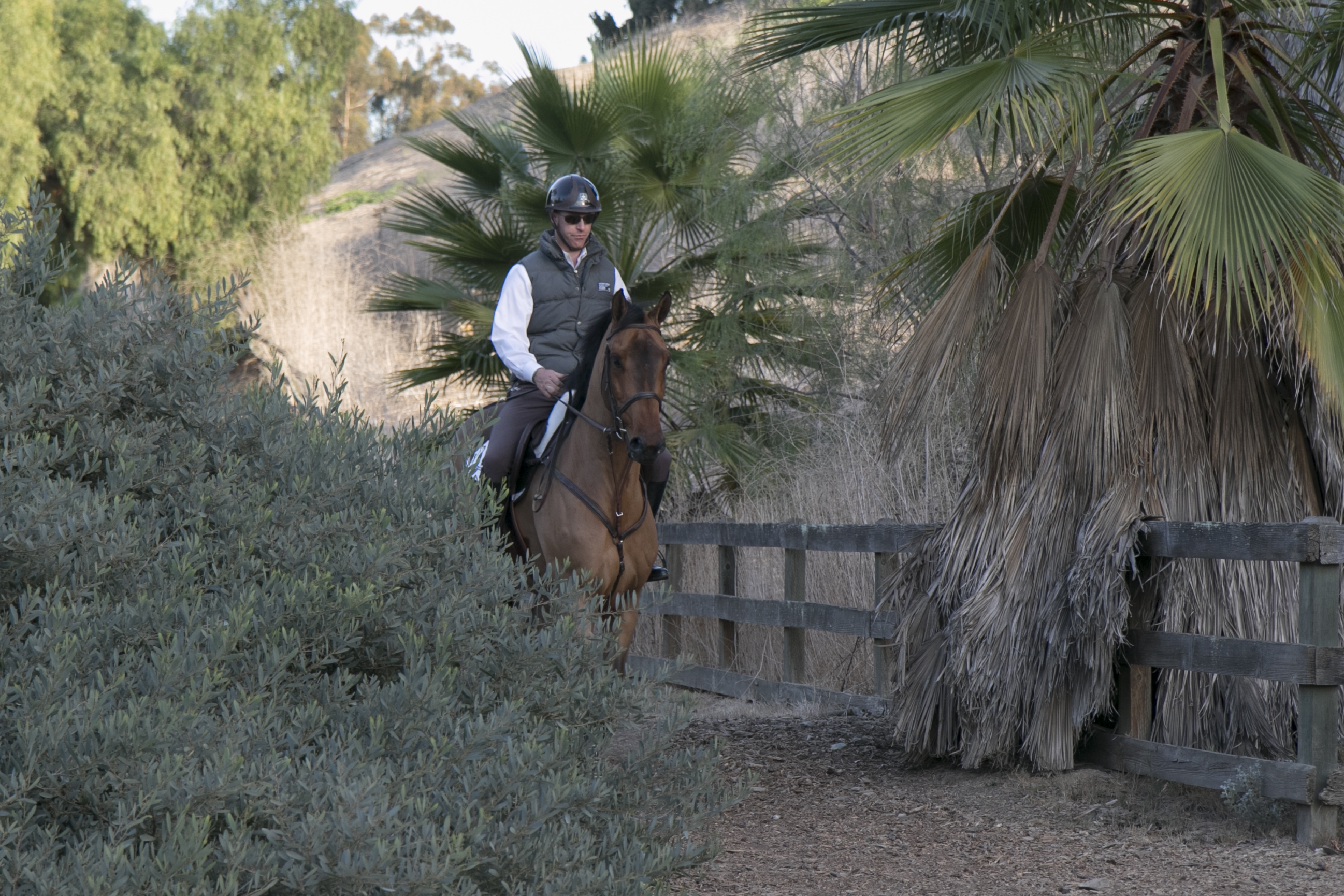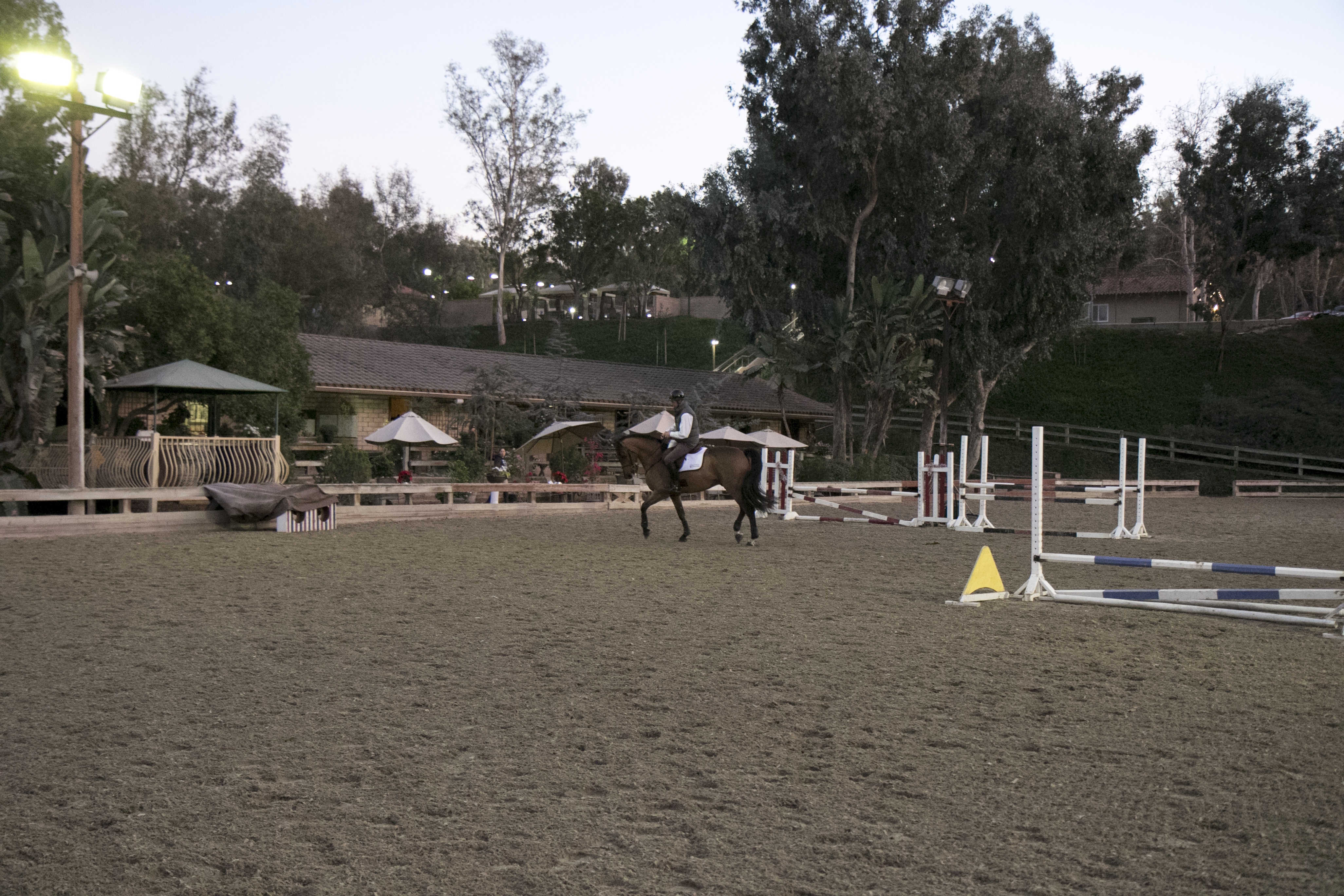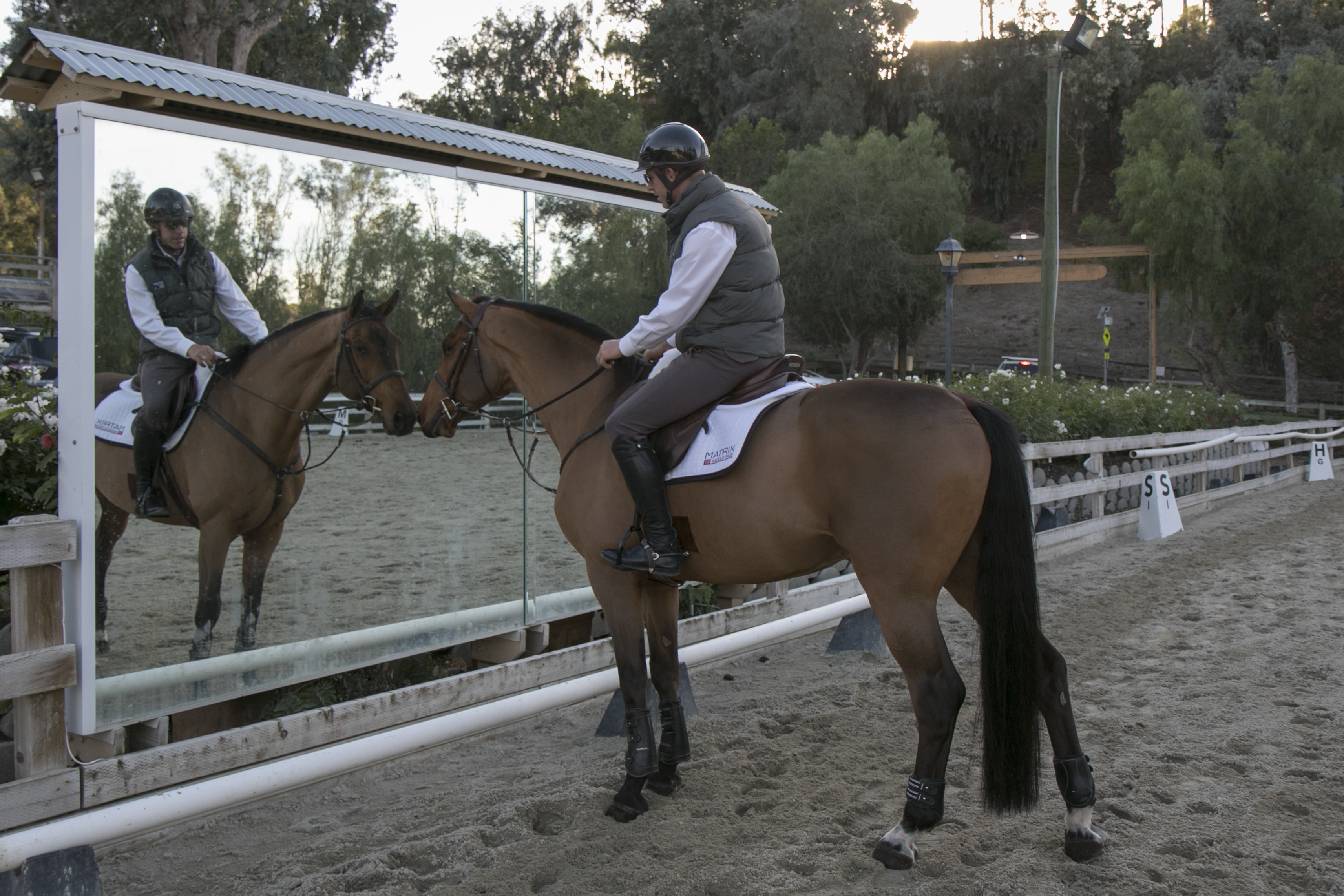At school there’s a reason they don’t teach math or social studies for the whole day. You can pack in only so much of the same thing at one time. I feel strongly that the same idea applies to training horses. I’ve seen great benefits from varying the exercises and environment in which I work with the horses in our jumper-oriented training program, whether they’re young and green or horses I’m riding at the grand prix level.

As a rider and trainer, I like to have a varied training approach because it gives me the benefit of looking at my horse from several angles and in different situations and that helps me understand him better.
In addition to typical arena schooling, I work horses in-hand, on the longe line, in long lines, loose in the round pen and out on the trail. Among those, trail riding is a particular favorite and one I recommend to almost all riders, provided they have the basic level of competence and security in the saddle to do so safely.
Because trail rides often include a few scary situations—at least from the horse’s perspective—teaching your horse that he needs to listen to your aids and trust you as his leader, no matter where you are, can help. Both of those behaviors translate to more responsiveness in the arena and a better bond with your horse. In addition, the change of scenery that comes anytime you get out of the arena is a great mental break for both of you.
The many physical benefits of riding on the trail start with your horse learning to balance himself on different types of terrain and going up and down hills. Or I should say relearning to do these things. Horses are incredibly agile on their feet if we allow them to be. They weren’t meant to go on only perfectly manicured footing. Think of wild horses galloping at full speed across the desert or over rocky plains.
Of course, if they’re not used to riding on different terrain, it takes a while for them to gain that agility and their proprioception—their sense of where their feet and the rest of their body parts are in relation to the terrain. When they improve their natural agility, it really helps their ability to adjust to anything that comes up on a tricky course or to recover from a misstep.
Walking and trotting up hills is great for building hindquarter muscles that propel a horse’s engaged work on the flat and his takeoff over fences. And there’s no better way to understand an “uphill” and “downhill” frame of carriage than actually riding your horse up and down a hill. It doesn’t have to be a steep hill to give you a clear sense for how it feels when your horse is in that desired uphill frame versus the on-the-forehand sensation of riding downhill.
When you go to places like Spruce Meadows in Calgary or any derby field where part of the course is set on a slight incline or decline, you’d be surprised how a little bit of up- or downhill changes the balance. Often it’s enough to throw the horse and/or the rider off of their distance to an upcoming fence or put the rider into a precarious position in the saddle.
I usually mix up periods of loose work and collected work while out on the trail. The loose work enables the horse to stretch his head and neck, although my contact is never so loose that I’d lose control if something startled him. In collected work, I’ll have the horse a little bit framed up to work on engagement and muscle development. I usually include walking and trotting and sometimes the canter on a long, flat stretch.
On a weekly basis, most of our horses get at least one trail ride; two is good and three times is great. Fitness trail rides that emphasize strong hill and collection work are never done on back-to-back days because the horse’s muscles need time to recover. I wouldn’t do more than three fitness trail rides in a week, but I might get in more trail work by using a short trail ride as a warm-up to whatever we’re going to work on in the arena—say 10 or 15 minutes of light work on the trail in place of flatwork in the ring.
In the Arena
Trail rides often include a few scary situations, so it’s imperative for your horse to listen to your aids and trust you as his leader, no matter where you are. To start gaining those qualities, you begin trail-ride training in the arena.

Figure out His Bubble
In our program, a beginner rider never goes out on the trail until she’s established a solid seat at all gaits. Her first of many rides outside the arena are on a horse who’s very comfortable on a trail. When an experienced rider comes to us with her own horse, I take the horse on a trail ride first before I encourage them to go out.
If you or your horse are not experienced with trail rides or you are concerned about coping with unfamiliar scenarios outside the ring, you’ll want to start slowly by introducing him to unfamiliar objects in the arena and progressively work your way outside of it.
As you ride, think about what concerns your horse. Fear is an interesting thing. I have one horse who is afraid of sprinklers and nothing else. Another horse won’t jump over a liverpool with a blue liner but has no problem going over one with a red liner. Pretty soon, you’ll start being able to guess what your horse is afraid of. Just as if you had a friend who didn’t like the chair lifts at a ski resort, you can probably guess she won’t like an elevator. With enough experience and exposure, you can start to determine what is going to be a problem for your horse.
Unfamiliar objects in the arena include anything that’s new to your horse. Be creative. Throw a tarp over a fence rail, put a banner on the arena wall, pile some orange traffic cones in the middle of the ring or stack jump poles in the corner.
Strategies that are able to help your horse overcome his fear of something foreign include:
- School him in part of the ring that’s away from the scary object or area, then let him rest near it so it becomes a place of sanctuary.
As you’re working him a safe distance from whatever he’s afraid of, ignore that spooky thing and encourage him to listen to your leg. If he speeds up, slows down or shies away in response to the scary object, your primary focus needs to be about him responding to your aids in an appropriate manner, not about the object. When your horse stays on the aids, you can gradually move him closer to the fearful thing.
- Walk beside or around the object rather than over it.
- Have another horse—provided they are buddies—approach the object just ahead of your horse.
Throughout this part of your ride, work on understanding your horse. This includes knowing what I call his “bubble” of how much fear he can tolerate in a situation that scares him. I call it a “bubble” because that perimeter has a little bit of flexibility and if you push it too quickly or too far, it will pop.
Every horse’s bubble is different, and you have to allow your horse to show you where his bubble is by getting him to the edge of his comfort zone. Tense muscles and a raised head are often the early signs of your horse forming his bubble. The next sign may be an unwillingness to move forward. You’re still OK at that point, but when you sense that he’s going from being alert and tuned in to you to wanting to turn and run away, he’s showing you his edge. That’s when you need to let your horse move away from the scary thing. Go to another part of the ring and do a little bit of complicated schooling work to focus his mind on you and away from the object until he softens his demeanor, both physically and mentally. He’ll show this to you by lowering his head, relaxing his muscles and being willing to go forward. Then address the spooky item again.

Take It to the Trail
When your horse is comfortable approaching unfamiliar or spooky objects in the arena, you can start to do the same thing outside the arena. Introduce him to the idea of trail riding by riding him anywhere safe around the stable grounds. At my barn, we have stalls that face the outdoors, so I will walk a young or green horse up and down the row next to the stalls. You can also walk around the property perimeter and as close as you can get to the outbuildings, the manure pile, the tractor shed, the dumpster, etc.
Progress from the least to the most-spooky areas gradually as you did in the arena. Don’t march right out there and try to fix your problem. Always make sure he is tuned in to your aids and moving forward.
Once you are confident of keeping your horse’s responsiveness to your aids even when he’s fearful of something, you’re ready to take that skill out on a trail. The unpredictability of things you’ll encounter on a trail adds to the challenge, but if you have established responsiveness and trust, you should be prepared for it.
Barking dogs are a common encounter. The trails that we have access to weave through a residential neighborhood where dogs often appear at their property’s fence line with what can seem like little warning. It’s very rare, however, that a horse is unaware of what’s coming. Usually you can feel your horse’s energy and nervous attitude before the barking begins and the dogs appear.
When you feel that nervous energy, stop, take a breath and figure out why your horse is nervous. It’s really important that you exude confidence in whatever command you give at this point. Typically, you would want to put the horse on your leg and hand aids as you walk back and forth along the fence line separating you from the barking dog, maybe adding a reassuring pat to the neck. People sometimes don’t realize that putting a horse on the aids and patting him actually increases his confidence. It’s like a parent taking her child’s hand to cross the road. You are saying, I understand you are afraid, but this is where we are going.
It’s amazing how fast a horse can go from being very afraid of something to being OK with it. Often, fear of the unknown stays if we don’t allow enough time for the horse to assimilate what is actually going on. (This is all assuming the dog is contained in a fenced property. Dealing with an aggressive dog that’s loose is a whole different story!)
If you are having trouble with the dogs or anything else that’s moving, return to an area he considers safer and find something that’s spooky to your horse but is stationary. A water trough, for example, might be frightening, but it’s not going to move. In any kind of training, there’s always a way to break things down. If you can’t jog, you walk. If you can’t walk, you crawl. Take things one step at a time and you’ll get where you want to go.
For jumper riders especially, try to find little logs to jump over or narrow spaces to go through. Horses tend not to like claustrophobic spaces, so utilizing one is another chance to establish the idea that responding to your aids is more important than what he doesn’t like. Our trails include two short tunnels that go under the roads of the stable’s Nellie Gail Ranch neighborhood, an equestrian community.
Unusual situations like these often trigger resistance from the horse and they are an opportunity to reinforce the idea that he cannot deny your leg aid. You really miss a training opportunity if your horse balks at something and you decide it doesn’t matter because he’s not doing that in front of a jump on course. Instead, I see these challenges on a trail as emulating problems that arise on course when a horse is fearful of a specific jump. I think other disciplines have a better understanding that exposing our horses to a variety of situations and environments is a great way to enhance their training for their own sport.
In addition to including variety in your horse’s routine while continuing his training and conditioning, trail riding is a great way to simply enjoy time with your horse, which I believe is an important part of good horsemanship.
Tips for Successful Trail Riding
- Take realistic stock of your own abilities and what you know and expect about your horse’s tolerance for the unpredictable situations that can be common on a trail ride. If you are at all concerned that you might not be able to handle your horse, enlist the help of a professional.
- For beginners, go out on a trail only when you’ve established a solid seat at all gaits. Initially, try to go out on a horse who’s very comfortable on a trail.
- A tired horse is usually a relaxed horse, so I almost always recommend tackling the trail on a horse not already accustomed to it after a good, solid workout in the arena.
- The buddy system can be effective. Many horses react well to having a calm, seasoned trail horse go along and take the lead during the ride. I typically recommend that the other horse have an experienced rider.
About Lane Clarke
Lane Clarke is partners with trainer Mickey Hayden in Hayden Clarke Sport Horses in Southern California’s Laguna Hills. He was born in Australia and moved to the U.S. as a toddler with his family. Lane’s father, Allen Clarke, is a horseman renowned for success with young horses and problem horses. Lane’s mother, Meredith, and brother, Lyn, are farriers.
Under his father’s tutelage, Lane attained success in the jumper ranks as a junior and came to the attention of Mickey, who had equal appreciation for Lane’s ability and his work ethic. Lane began as a working student, earned a paid-assistant post as a teenager and was made a partner in the business in January 2017. Along the way, he has coached students and campaigned horses up to grand prix. Recent major placings include winning the $75,000 HITS Coachella Desert Circuit Grand Prix and finishing third in the $100,000 Longines FEI World Cup™ Thermal qualifier in 2017.
His emphasis on variety in training horses reflects what he learned from his father and from Mickey, mixed with personal experiences. Lane, 33, and his wife, equine veterinarian Jennifer Reese Clarke, DVM, have a 3-year-old daughter, Emerson.
This article was originally published in the July 2018 issue of Practical Horseman.










